Building strength is defined by more than moving heavy weights—it’s about creating a balanced routine that challenges your muscles, improves overall functionality, and enhances your performance. If you’re looking for a fitness routine that targets all the major muscle groups, boosts your strength, and fits into a busy schedule, this three-day full-body workout plan to build strength is your answer. It’s designed to optimize your efforts in the gym while allowing enough recovery to maximize your results.
This plan includes a blend of compound lifts, functional movements, and hypertrophy exercises to ensure you hit your muscles from all angles. Each workout is structured with supersets, tri-sets, and smart rest periods to keep your intensity high and your sessions efficient. Whether you’re a seasoned lifter or just stepping into strength training, this routine can be tailored to match your fitness level while providing a solid foundation for growth.
The workouts range from full-body strength builders to targeted hypertrophy circuits, crafting the ability to build power, enhance muscle endurance, and improve your overall physique. You only need dedication, some essential equipment, and an hour or so to commit to each session. Be in tune with your weekly progressions, focus on recovery, and bring effort to each session to maximize your results.
In This Article
The Secret to Building Strength
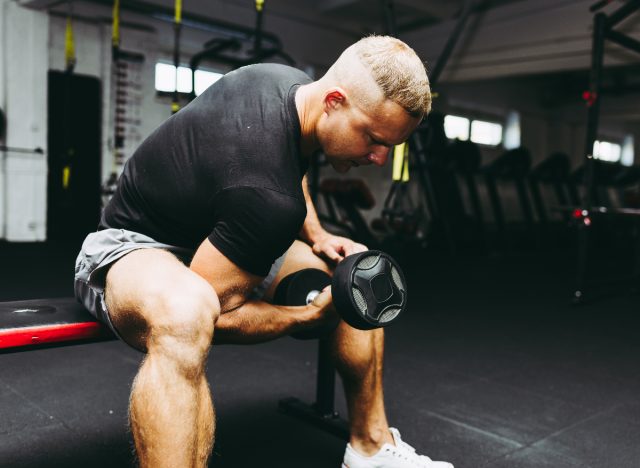
The secret to building strength is finding the right balance between effective programming, proper recovery, and consistency. Sticking to evidence-based principles can build strength efficiently while staying injury-free.
Set and Rep Ranges for Strength Gains
Optimal strength-building happens within a specific range of volume and intensity. Aim for 10–20 total sets per muscle group per week, divided across your training days. For each exercise, working in the 5–12 rep range is ideal—fewer reps with heavier loads for building maximal strength and higher reps with moderate weight to improve muscular endurance and hypertrophy.
Compound movements like squats, deadlifts, bench presses, and pull-ups should form the foundation of your workouts, as they engage multiple muscle groups and allow for progressive overload.
Smart Programming and Rest Periods
Full-body workouts are a time-efficient way to hit all major muscle groups and ensure balanced development. Performing 2–3 full-body sessions per week provides enough volume to drive strength gains without overtraining. Between sets, rest for 2–3 minutes for heavy lifts like squats or deadlifts to allow optimal recovery and 60–90 seconds for accessory exercises or supersets to maintain intensity. This strategic approach will enable you to sustain high performance throughout each session.
Hit Your Compound Lifts
If you want to build serious strength, compound lifts should be the cornerstone of your training program. These multi-joint movements, like squats, deadlifts, bench presses, overhead presses, and pull-ups, recruit multiple muscle groups at once, making them incredibly efficient for gaining strength and muscle. They also allow you to lift heavier weights, triggering the neuromuscular adaptations necessary for building raw power.
Prioritize Recovery
Strength is built during recovery, not just in the gym. To maximize your results, prioritize rest days, quality sleep, and nutrition. Incorporate active recovery techniques like walking, stretching, or yoga to improve circulation and reduce muscle soreness. Foam rolling and massage can also help alleviate tension and support muscle repair. Additionally, ensuring your diet includes adequate protein (1.6–2.2 grams per kilogram of body weight) and carbohydrates fuels your training and aids recovery.
Workout #1: Full-Body Strength Builder
What you need: A barbell with plates, a bench, dumbbells, and a sturdy surface for planks. This workout will take about 60–75 minutes, including warm-up and rest periods.
The Routine:
- A1. Back Squat (4 sets of 5 reps)
- A2. Bench Press (4 sets of 6 reps)
- B1. Single-Arm Dumbbell Rows (3 sets of 8–12 reps)
- B2. Barbell Hip Thrust (3 sets of 6–8 reps)
- B3. Plank Up-Downs (3 sets to fatigue)
Directions: Exercises A1 and A2 should be performed as a superset, resting for 2 minutes between sets. Exercises B1, B2, and B3 should be performed as trisets, resting for 1:30 between sets. Rest for 3 minutes when transitioning between groups. Always perform 2–4 warm-up sets, gradually increasing the weight for each working set. Use the same weight for all working sets of each exercise.
How to Do It:
A1. Back Squat

- Set a barbell at shoulder height in a squat rack. Step under the bar, positioning it across your upper back.
- Unrack the bar, step back, and position your feet shoulder-width apart.
- Inhale, brace your core, and lower your body by bending at the hips and knees until your thighs are parallel to the floor.
- Exhale and drive through your heels to return to a standing position.
A2. Bench Press

- Lie flat on a bench with your feet planted on the ground.
- Grip the barbell slightly wider than shoulder-width.
- Unrack the bar and position it directly over your chest.
- Lower the bar slowly to your chest while keeping your elbows at a 45-degree angle.
- Press the bar back up to the starting position.
B1. Single-Arm Dumbbell Rows
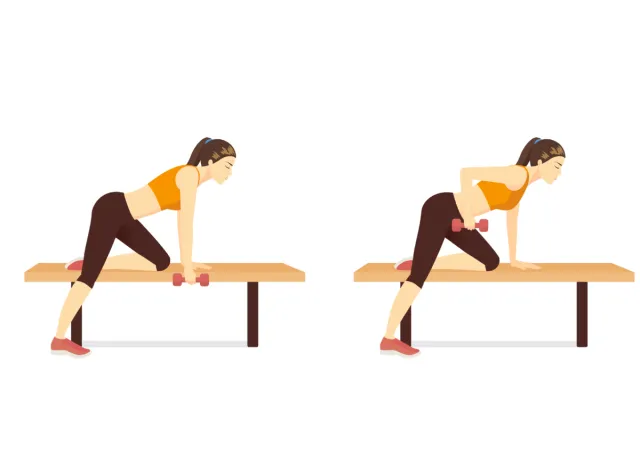
- Place your left knee and hand on a bench for support, holding a dumbbell in your right hand.
- Keep your back flat and row the dumbbell toward your hip, squeezing your shoulder blade at the top.
- Lower the weight under control and repeat on both sides.
B2. Barbell Hip Thrust

- Sit on the floor with your upper back against a bench and a barbell across your hips.
- ]Roll the barbell over your thighs and position your feet flat on the ground, hip-width apart.
- Drive through your heels to lift your hips until your body forms a straight line from shoulders to knees.
- Lower back down with control.
B3. Plank Up-Downs

- Start in a forearm plank position with your elbows directly under your shoulders.
- Push up onto your hands one arm at a time to transition into a high plank.
- Lower back down to a forearm plank one arm at a time.
- Repeat.
Workout #2: Full-Body Strength Builder Pt. 2
What you need: A barbell, dumbbells, and a lat pulldown machine. This workout takes approximately 60–75 minutes, including warm-ups and rest periods.
The Routine:
- A1. Deadlift (Work to 1 set of 5, then 3 sets of 5 at 85% of your top set)
- B1. Lat Pulldown (3 sets of 12 reps)
- B2. Seated Dumbbell Shoulder Press (3 sets of 8 reps)
- B3. Dumbbell Walking Lunge (3 sets of 6 reps per leg)
- C1. Weighted Toe Touches (3 sets of 10 reps)
- C2. Side Plank with Hip Dips (3 sets of 10 reps per side)
Directions: Rest for 2 minutes between deadlift sets, 1:30 between exercises in group B, and 1 minute between exercises in group C. Perform 2–4 warm-up sets before the working sets of the deadlift.
How to Do It:
A1. Deadlift
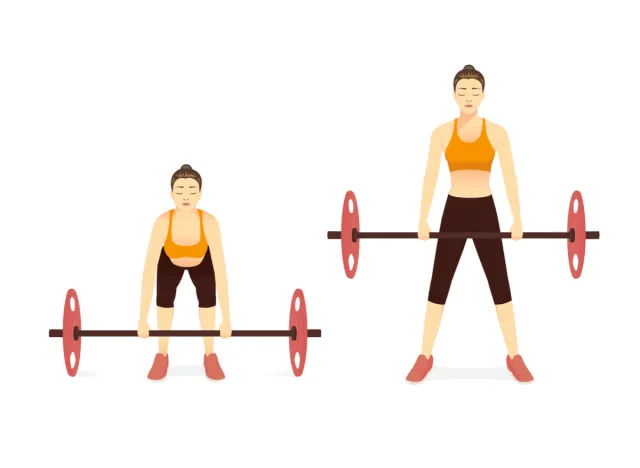
- Stand with your feet hip-width apart and the barbell over the middle of your feet.
- Bend at the hips and knees to grip the bar just outside your knees.
- Inhale, brace your core, and lift the bar by extending your hips and knees simultaneously.
- Lower the bar under control back to the starting position.
B1. Lat Pulldown
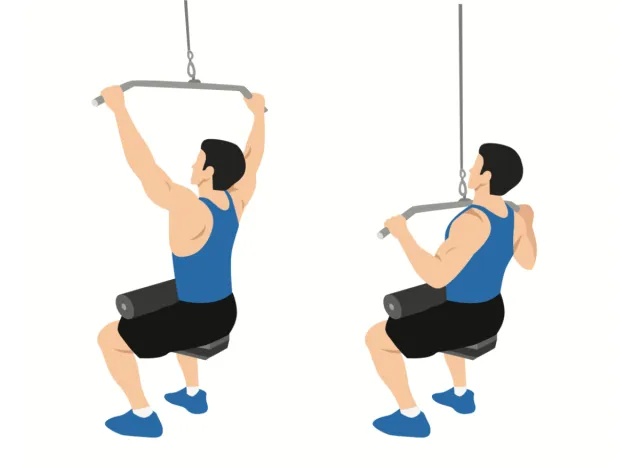
- Sit on the lat pulldown machine and grip the bar slightly wider than shoulder-width.
- Pull the bar down to your chest while keeping your back straight.
- Slowly return the bar to the starting position.
B2. Seated Dumbbell Shoulder Press
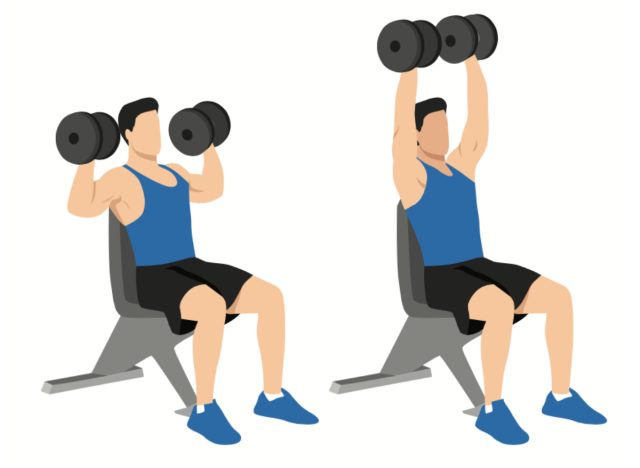
- Sit on a bench with back support, holding dumbbells at shoulder height with palms facing forward.
- Press the dumbbells overhead until your arms are fully extended.
- Lower them back to the starting position.
B3. Dumbbell Walking Lunge

- Hold dumbbells at your sides and step forward with one leg.
- Lower your body until your front knee is at 90 degrees.
- Push off your front foot to step forward with the opposite leg.
- Repeat.
C1. Weighted Toe Touches
- Lie on your back, holding a dumbbell with both hands above your chest.
- Raise your legs to 90 degrees and reach toward your toes with the dumbbell.
- Lower back down and repeat.
C2. Side Plank with Hip Dips

- Lie on your side and support your body on your forearm and feet.
- Dip your hip toward the ground and lift it back up.
- Repeat on both sides.
Workout #3: Total-Body Hypertrophy
What you need: Dumbbells, a bench, and a mat. This workout takes approximately 60–70 minutes, including warm-ups and rest periods.
The Routine:
- A1. Dumbbell Bulgarian Split Squat (3 sets of 6–8 reps per leg)
- A2. Chin-Ups (3 sets of 6–12 reps)
- B1. Dumbbell Incline Bench Press (3 sets of 12 reps)
- B2. Romanian Deadlift (3 sets of 6–8 reps)
- B3. Russian Twists (3 sets of 15 reps per side)
- C1. Dumbbell Curls (3 sets of 15 reps)
- C2. Dumbbell Tricep Extensions (3 sets of 12 reps)
- C3. Dumbbell Lateral Raise (3 sets of 8 reps)
Directions: Exercises A1 and A2 are performed as a superset, resting for 1:30 between sets. Exercises B1, B2, and B3 are performed as trisets, resting for 1:30 between sets. Exercises C1, C2, and C3 form a finisher, resting for 1 minute between sets. Warm up with 2–4 sets before your working sets, gradually increasing the weight.
How to Do It:
A1. Dumbbell Bulgarian Split Squat

- Stand a few feet before a bench, holding dumbbells at your sides.
- Place one foot behind you on the bench, laces down.
- Lower your body until your front thigh is parallel to the ground, keeping your torso upright.
- Drive through your front heel to return to the starting position.
A2. Chin-Ups

- Grab a pull-up bar with an underhand grip, hands shoulder-width apart.
- Hang onto the bar with your arms fully extended.
- Pull yourself up until your chin is above the bar.
- Lower back down with control and repeat.
B1. Dumbbell Incline Bench Press
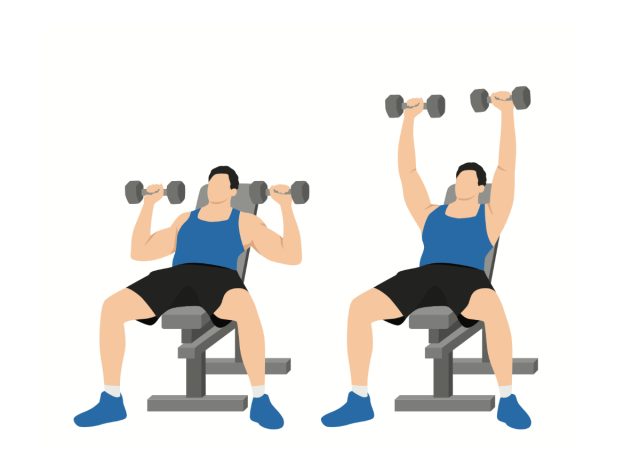
- Set a bench to a 30–45-degree incline and sit with dumbbells resting on your thighs.
- Lie back and press the dumbbells above your chest, palms facing forward.
- Lower the dumbbells to chest level, then press them back up.
B2. Romanian Deadlift

- Hold dumbbells in front of your thighs with your feet hip-width apart.
- Hinge at the hips to lower the dumbbells down your legs while keeping a slight bend in your knees.
- Stop when your torso is nearly parallel to the ground, then return to standing by driving your hips forward.
B3. Russian Twists
- Sit on the floor with your knees bent and feet lifted off the ground. Hold a dumbbell with both hands.
- Twist your torso to the right, bringing the dumbbell toward the floor.
- Return to the center and twist to the left. Repeat.
C1. Dumbbell Curls

- Stand with a dumbbell in each hand, palms facing forward.
- Curl the dumbbells up to shoulder level while keeping your elbows close to your sides.
- Lower back down with control.
C2. Dumbbell Tricep Extensions

- Hold a dumbbell with both hands and lift it overhead.
- Lower the dumbbell behind your head, keeping your elbows close to your ears.
- Extend your arms to return to the starting position.
C3. Dumbbell Lateral Raise

- Hold a dumbbell in each hand at your sides, palms facing your torso.
- Raise your arms out to the sides until they’re at shoulder height.
- Lower them back down with control.








